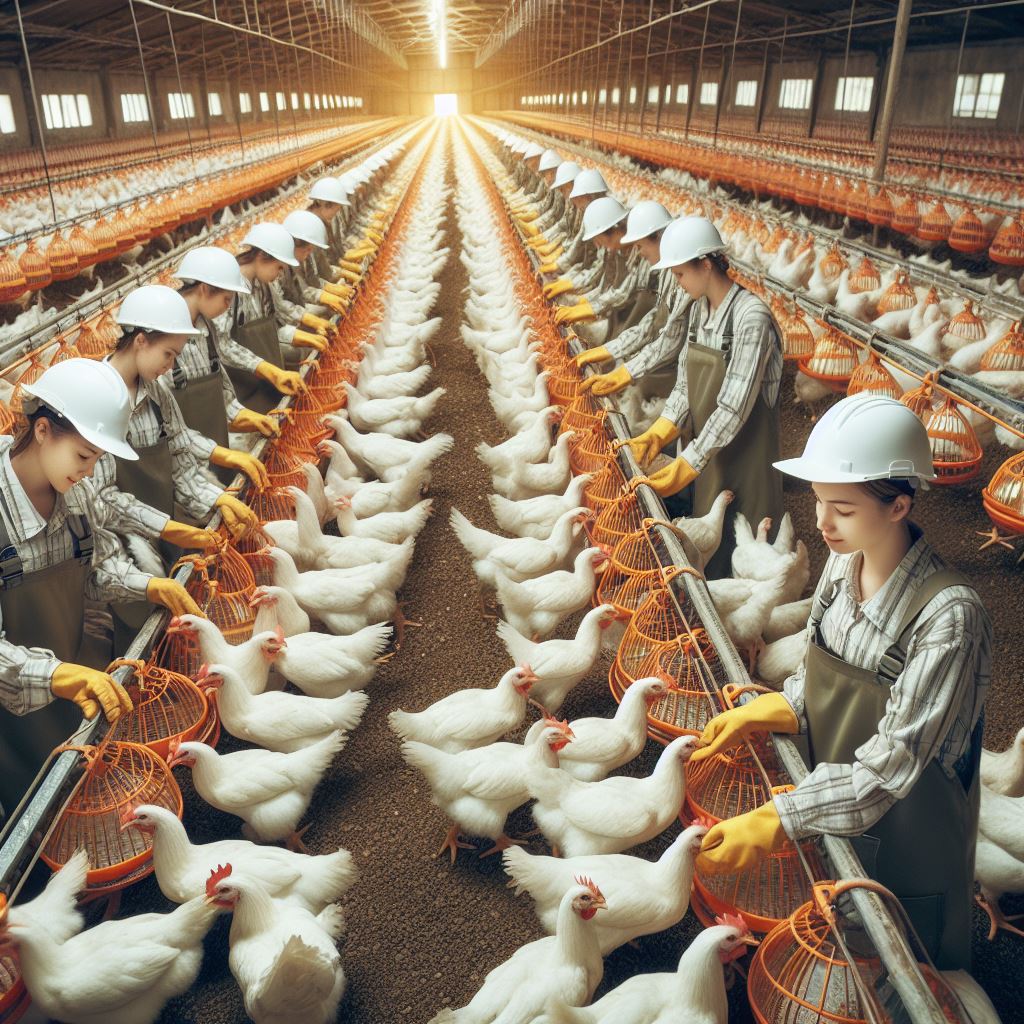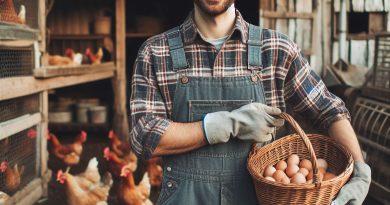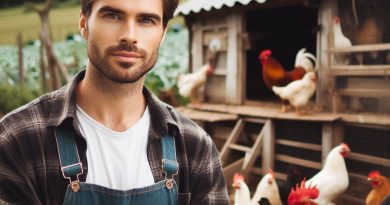Poultry Behavior: Understanding Your Flock
Last Updated on January 26, 2024
Introduction
Understanding poultry behavior is essential for farmers to ensure the well-being and productivity of their flocks.
By observing and comprehending how chickens behave, farmers can implement better management practices and create a healthy environment for their poultry.
A. Importance of Understanding Poultry Behavior
Understanding poultry behavior allows farmers to identify signs of stress or illness in their flock.
It helps them prevent problems such as cannibalism, feather pecking, and aggression.
Farmers can quickly intervene and provide necessary interventions to maintain a harmonious group dynamic within their flock.
Moreover, knowing how chickens behave allows farmers to optimize flock management.
They can create suitable housing, feeding, and lighting systems that align with the birds’ natural instincts, enhancing their overall well-being.
Understanding behavior also enables farmers to offer appropriate enrichment activities, reducing boredom and improving the birds’ mental health.
B. How Understanding Poultry Behavior Benefits Farmers
By understanding poultry behavior, farmers can achieve higher productivity levels and reduce economic losses caused by stress-related issues.
They can modify husbandry practices to improve egg production, minimize mortality rates, and enhance feed conversion efficiency.
Additionally, being knowledgeable about poultry behavior helps farmers reduce the use of medications and antibiotics.
They can implement preventive measures based on behavior indicators, which have a positive impact on the flock’s health and reduce the risk of disease outbreaks.
Farmers who understand poultry behavior can also enhance their overall animal welfare practices.
By providing appropriate environmental enrichment and management, they create a more natural and stress-free environment for their birds.
In essence, grasping poultry behavior empowers farmers to make informed decisions regarding flock management, animal welfare, and disease prevention.
It ultimately leads to more sustainable and profitable poultry farming practices.
Basic Understanding of Poultry Behavior
Poultry behavior refers to the way chickens, ducks, and other domesticated birds act and interact with their environment.
Understanding poultry behavior is crucial for backyard chicken owners as it helps ensure the well-being and productivity of their flock.
A. Natural Instincts of Poultry
- Poultry have a strong instinct for social interaction and hierarchy within the flock.
- They have a natural inclination to roost at elevated places, seeking safety from predators.
- Poultry also have a strong instinct for foraging, scratching the ground in search of food.
- Mother hens instinctively protect and care for their chicks, exhibiting maternal behaviors.
- Poultry have an innate ability to communicate through vocalizations and body language.
B. Importance of a Safe and Comfortable Environment
- A safe environment protects poultry from predators, ensuring their physical well-being.
- Providing a comfortable environment reduces stress and improves overall flock health.
- Avoiding overcrowding is vital to prevent aggression and the spread of diseases.
- Proper ventilation and temperature control are essential for the flock’s comfort.
- Reducing noise levels and disturbances promotes a calm and stress-free environment.
C. Basic Needs and Behaviors of Poultry (Feed, Water, Rest, etc.)
- Feeding poultry a balanced diet keeps them healthy and supports egg production.
- Access to fresh and clean water is crucial for hydration and proper bodily functions.
- Poultry require a sufficient amount of rest and sleep to maintain good health.
- Dust bathing is a natural behavior that helps poultry keep their feathers clean and healthy.
- Sunbathing allows birds to absorb vitamin D, essential for calcium absorption and bone health.
- Nesting behavior, such as seeking secluded spots to lay eggs, is a typical poultry behavior.
- Poultry are drawn to exploring their surroundings, which stimulates their natural curiosity.
- Pecking and scratching the ground are instinctive behaviors related to foraging and searching for food.
- Poultry have a social hierarchy and may exhibit behaviors such as pecking order establishment.
- Migration and escape behaviors can occur if poultry feel threatened or are exposed to danger.
By understanding the basic instincts, needs, and behaviors of poultry, flock owners can provide a suitable environment that promotes their well-being and productivity.
Observing and interacting with the flock allows owners to recognize abnormal behaviors early and take necessary actions to maintain a healthy and contented flock.
Read: Poultry Genetics: Raising Superior Chickens
Communication and Social Behavior in Poultry
Poultry, like humans, have unique ways of communicating with each other.
Understanding their social behavior can help you build a stronger connection with your flock.
In this section, we will explore the different aspects of poultry communication and social behavior.
A. Visual communication (body language, gestures)
Poultry, especially chickens, use body language and gestures as a form of visual communication.
These signals can convey various messages to other members of the flock.
Some common examples include:
- Head bobs: A quick nod of the head can indicate dominance or submission within the flock.
- Wing spreading: It is a way for poultry to establish their territory and display dominance.
- Pecking: Pecking can be a friendly gesture of grooming or a sign of aggression if they are targeting another bird’s feathers.
Understanding these visual cues can help you interpret the behavior of your flock and identify any potential issues or conflicts.
B. Vocalizations and their meanings
Poultry also use vocalizations to communicate with each other.
Each sound has a specific meaning or purpose.
Here are some common vocalizations and their meanings:
- Clucking: Hens often cluck softly to communicate with their chicks or to express contentment.
- Crowing: Roosters crow to establish their dominance and communicate their presence to the entire flock.
- Squawking: A loud squawk can indicate distress or a warning of danger.
By listening to their vocalizations, you can better understand the needs and emotions of your poultry.
C. Hierarchy and pecking order
Like many social animals, poultry have a hierarchical structure within their flock.
The pecking order determines the social ranking of each bird.
Establishing a pecking order helps maintain order and reduce aggression within the flock.
Some key points about the pecking order are:
- Dominance: The top-ranking bird has the highest status and access to resources.
- Subordination: Lower-ranking birds defer to those higher in the pecking order.
- Socialization: Establishing a pecking order involves various interactions such as pecks, challenges, and displays of dominance.
It is crucial to monitor the pecking order to prevent excessive bullying or stress among your poultry.
D. Flock dynamics
Understanding flock dynamics is essential for managing your poultry effectively.
Flock dynamics refer to the interactions, relationships, and overall behavior of the flock as a whole.
Here are some important factors to consider:
- Bonding: Poultry, especially chickens, form strong social bonds within their flock, providing them with a sense of security and stability.
- Social learning: Chickens learn from each other through observation and imitation, leading to the spread of behaviors and habits.
- Mobility: Poultry tend to move together as a group, providing safety in numbers and enabling coordinated actions.
By studying the flock dynamics, you can create a healthy and harmonious environment for your poultry.
In general, understanding the communication and social behavior of poultry is crucial for successful flock management.
By observing their visual cues, interpreting their vocalizations, respecting the pecking order, and recognizing flock dynamics, you can establish a strong bond with your flock and ensure their well-being.
Stay tuned for the next section, where we will delve into the nutritional needs of poultry for optimal health and productivity.
Read: Innovative Poultry Housing Solutions in 2024

Common Behavioral Issues in Poultry
A. Feather pecking and cannibalism
Feather pecking, a major issue in poultry, occurs when birds pluck feathers from each other.
Cannibalism is a severe form of feather pecking, where birds injure and consume the feathers.
1. Causes of feather pecking and cannibalism
- Overcrowding: Birds become stressed due to lack of space, leading to aggressive behaviors.
- Boredom: Insufficient environmental enrichment causes birds to redirect their frustration towards feather pecking.
- Nutritional deficiencies: Imbalanced diets can result in feather pecking as birds seek alternative food sources.
- Genetic predisposition: Some breeds are more prone to feather pecking than others.
2. Preventing and managing feather pecking and cannibalism
- Provide adequate space: Ensure the number of birds per square foot is within recommended limits.
- Enrich the environment: Offer pecking toys, perches, and dust baths to keep birds mentally stimulated.
- Balanced nutrition: Provide a complete and balanced diet to meet the nutritional requirements of the flock.
- Genetic selection: Breeders should focus on selecting birds with lower tendencies for feather pecking.
B. Aggression and territoriality
Aggression among poultry arises from social hierarchy establishment and territorial disputes.
Roosters are particularly prone to aggressive behaviors, including spurring, pecking, and chasing.
1. Causes of aggression and territoriality
- Limited resources: Competition for food, water, and nesting areas can lead to aggressive interactions.
- Hormonal changes: Breeding season or hormonal imbalances can intensify aggression among males.
2. Preventing and managing aggression and territoriality
- Sufficient resources: Ensure an abundance of feeders, waterers, and nest boxes to reduce competition.
- Space management: Provide ample room for birds to establish their territories and minimize conflicts.
- Separation: Temporarily separate aggressive birds to prevent injuries to the rest of the flock.
- Castration: In extreme cases, castrating aggressive roosters may help reduce aggressive behaviors.
C. Fearful behaviors
Poultry can exhibit fearful behaviors such as hiding, excessive vocalization, and reduced movement.
Fear can have detrimental effects on the overall well-being and productivity of the flock.
1. Causes of fearful behaviors
- Predators and perceived threats: Poultry are instinctively wary of potential predators, causing fear responses.
- Stressful environments: Loud noises, sudden changes, or overcrowded conditions can induce fear in birds.
2. Preventing and managing fearful behaviors
- Predator control: Install proper fencing, netting, and lighting to minimize predator threats.
- Provide a safe environment: Ensure the housing and surroundings are secure and free from potential dangers.
- Gentle handling: Approach birds calmly and avoid sudden movements that may startle them.
- Reduce stressors: Minimize noise, maintain consistent routines, and avoid overcrowding to reduce fear in birds.
D. Abnormal behaviors and their causes
Abnormal behaviors in poultry include repetitive pecking, excessive egg eating, and self-mutilation.
These behaviors can result from a combination of genetic, environmental, and management factors.
1. Causes of abnormal behaviors
- Frustration and boredom: Lack of stimulation and environmental enrichment can lead to abnormal behaviors.
- Social stress: Social hierarchy conflict or overcrowding can contribute to the development of abnormal behaviors.
2. Preventing and managing abnormal behaviors
- Environmental enrichment: Provide objects for pecking, perches, and dust baths to prevent boredom.
- Monitor flock dynamics: Intervene if aggressive behaviors or excessive pecking begin to occur.
- Adjust management practices: Ensure proper spacing, feeding routines, and lighting schedules to reduce stress.
- Seek professional advice: If abnormal behaviors persist, consult a poultry behavior specialist for guidance.
Understanding and addressing common behavioral issues in poultry is crucial for maintaining a healthy and productive flock.
By implementing preventive measures and proper management techniques, poultry owners can create a harmonious and stress-free environment for their birds.
Read: Poultry Health: Preventing Common Diseases
Understanding the Impact of Environment on Poultry Behavior
Poultry behavior is greatly influenced by their environment.
The conditions in which they are raised have a significant impact on their behavior, including their health, stress levels, and overall well-being.
It is crucial for poultry farmers to understand how various environmental factors affect their flock.
In this section, we will explore the effects of lighting, temperature, and ventilation on poultry behavior.
A. Lighting Requirements and its Effect on Behavior
- Poultry have specific lighting requirements that directly impact their behavior.
- Proper lighting ensures optimal growth, egg production, and overall performance of the flock.
- Insufficient or excessive lighting can cause stress, disturbances in reproduction, or even cannibalism among birds.
- Providing the correct lighting intensity and duration helps establish natural day-night cycles and maintains the circadian rhythm.
- Bright, uniform lighting reduces aggression and promotes calmness among the birds.
- Appropriate lighting programs can also encourage feeding and drinking behaviors.
B. Temperature Control and its Impact on Behavior
- Poultry are sensitive to temperature fluctuations as they lack sweat glands to regulate their body temperature.
- Maintaining the right temperature is crucial for physiological and behavioral well-being.
- Extreme cold or heat can lead to stress, reduced feed consumption, decreased egg production, and even mortality.
- Chilled birds tend to huddle together for warmth, while overheated birds may show signs of discomfort, panting, or lethargy.
- Proper temperature control promotes healthy growth, activity levels, and a balanced feed intake.
- Adequate insulation, heating, or cooling systems should be implemented to maintain the ideal temperature range for the flock.
C. Importance of Proper Ventilation
- Adequate ventilation plays a vital role in poultry behavior and overall flock health.
- Poor ventilation can lead to a buildup of harmful gases, ammonia, moisture, and pathogens, affecting the respiratory system of birds.
- Insufficient airflow can cause stress, increased disease susceptibility, and even death among the flock.
- Proper ventilation helps remove excess heat, moisture, and odors from the poultry house, ensuring fresh air circulation.
- Good air quality promotes respiratory health, reduces the risk of respiratory diseases, and improves overall welfare.
- Ventilation systems should consider the flock size, type of housing, and external environmental conditions for optimal performance.
In summary, understanding the impact of the environment on poultry behavior is essential for successful farming.
Lighting requirements should be met to maintain natural cycles and promote a calm flock.
Temperature control is crucial to preventing stress and promoting healthy growth.
Proper ventilation is necessary for the removal of harmful gases and the maintenance of excellent air quality.
By prioritizing these environmental factors, poultry farmers can provide a conducive environment for their flock, ensuring their well-being and productive behavior.
Read: Starting a Poultry Farm: Essential Steps & Tips
Strategies to Ensure Good Poultry Behavior
A. Providing adequate space
Provide enough space for each bird to move around comfortably and exhibit natural behaviors.
Overcrowding can lead to stress, aggression, and the development of undesirable behaviors.
B. Enrichment activities
Offer dust baths, perches, and toys to keep the birds mentally stimulated and physically active.
These activities help prevent boredom and reduce the likelihood of harmful behaviors, like feather pecking.
C. Quality diet
Ensure that poultry receive a balanced and nutritious diet to support their overall health.
Feed them a mix of grains, vitamins, minerals, and protein sources appropriate for their age and breed.
D. Regular observation and handling of the flock
Spend time observing the flock daily to identify any behavioral issues or signs of illness.
Handling the birds gently and regularly will make them more comfortable and easier to manage.
E. Minimizing stress factors
Reduce noise, bright lights, sudden changes, or other stressors in the poultry environment.
Stress can lead to aggressive tendencies and other negative behaviors, so maintaining a calm and stable environment is crucial.
Good poultry behavior is vital for the overall well-being and productivity of the flock.
By implementing strategies such as providing adequate space, enrichment activities, a quality diet, regular observation, and minimizing stress factors, you can help foster positive behaviors.
It is essential to remember that each bird is an individual, and monitoring their behavior regularly allows for early intervention and proper management.
Happy and healthy poultry will result in a successful and rewarding flock management experience.
Conclusion
Understanding poultry behavior is crucial for farmers to ensure better management and productivity.
By investing time in comprehending their flock, farmers can achieve optimal results.
A. Recap of the importance of understanding poultry behavior
It is vital to understand poultry behavior to provide appropriate care and meet their specific needs.
This understanding helps in creating a suitable environment, minimizing stress, and preventing potential issues.
B. Encouragement for farmers to invest time in understanding their flock for better management and productivity
Farmers should prioritize learning about their flock’s behavior patterns, social dynamics, and communication methods.
This knowledge allows them to identify signs of distress, provide proper nutrition, and ensure a healthy and balanced flock.
By investing time in understanding their flock, farmers can enhance productivity and overall profitability.


